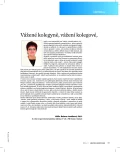Pulmonary nocardiosis in a geriatric patient
Authors:
Martina Kadlecová; B. Jurašková; J. Zajíc
Published in:
Geriatrie a Gerontologie 2017, 6, č. 2: 94-97
Category:
Case Reports
Overview
Nocardiosis is a rare infectious disease that, especially affects immunocompromised patients. The infection manifests in humans and animals. Genus Nocardia has more than 80 species, 33 of which can cause infection in humans. The most common species worldwide belong to the Nocardia asteroides complex. There are several types of Nocardia infection, the most common form being pulmonar. From the time of exposure to the appearance of symptoms and signs can be months or years. The clinical picture is very different depending on the affected organs, the radiologic findings are nonspecific and the cultivation takes a long time. For all these reasons, the diagnosis is extremely difficult to make (mostly in late phases or not at all). If Nocardia is found, the treatment takes several months, but even disseminated disease has a good prognosis.
KEYWORDS:
nocardiosis – Nocardia veterana – pneumonia at imunocompromised
Sources
1. Mandell GL, Benett JE, Dolin R (Eds). Principles and Practice of Infectious Diseases. 7. vyd. Philadelphia: Churchill Livingstone Elsevier 2010; 2. 3199–3208.
2. Roth A, Andrees S, Kroppenstedt RM, et al. Phylogeny of the genus Nocardia based on reassessed 16S rRNA gene sequences reveals underspeciation and division of strains classified as Nocardia asteroides into three established species and two unnamed taxons. Clin Microbiol 2003; 41 : 851.
3. Blümel J, Blümel E, Yassin AF, et al. Typing of Nocardia farcinica by pulsed-field gel electrophoresis reveals an endemic strain as source of hospital infections. J Clin Microbiol 1998; 36 : 118.
4. Exmelin l, Malbruny B, Vergnaud M, et al. Molecular study of nosocomial nocardiosis outbreak involving heart transplant recipients. J Clin Microbiol 1996; 34 : 1014.
5. Wenger PB, Brown JM, McNeil MM, Jarvis WR. Nocardia farcinica sternotomy site infections in patients following open heart surgery. J Infect Dis 1998; 178 : 1539.
6. Longo DL, Fauci A, Kasper D, et al. Harrison‘s Principles of Internal Medicine, 18. vyd. Mc Graw Hill 2012; 1 : 1322–1326.
Podpořeno výzkumným úkolem PROGRES – Q40/12.
Labels
Geriatrics General practitioner for adults Orthopaedic prostheticsArticle was published in
Geriatrics and Gerontology

2017 Issue 2
- Memantine Eases Daily Life for Patients and Caregivers
- Metamizole vs. Tramadol in Postoperative Analgesia
- What Effect Can Be Expected from Limosilactobacillus reuteri in Mucositis and Peri-Implantitis?
- Advances in the Treatment of Myasthenia Gravis on the Horizon
- Hope Awakens with Early Diagnosis of Parkinson's Disease Based on Skin Odor
Most read in this issue
- Delirium – new knowledge and experiences for clinical practice
- Palliative care at post-acute care facilities
- Pulmonary nocardiosis in a geriatric patient
- The cognitive disorder is not always dementia
